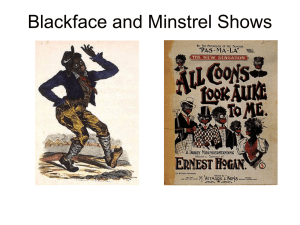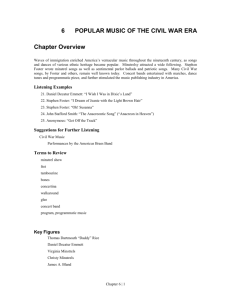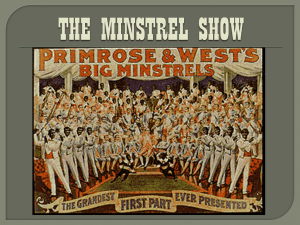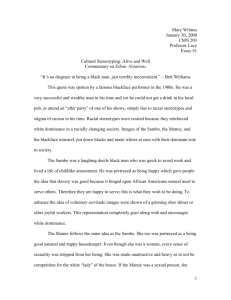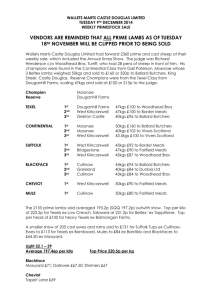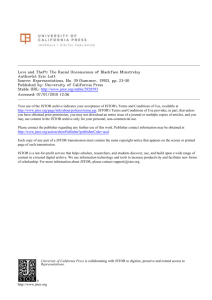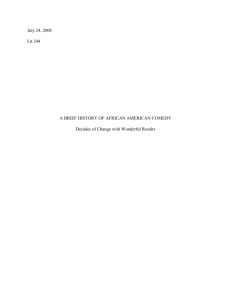Blackface Minstrelsy and Stereotypes
advertisement
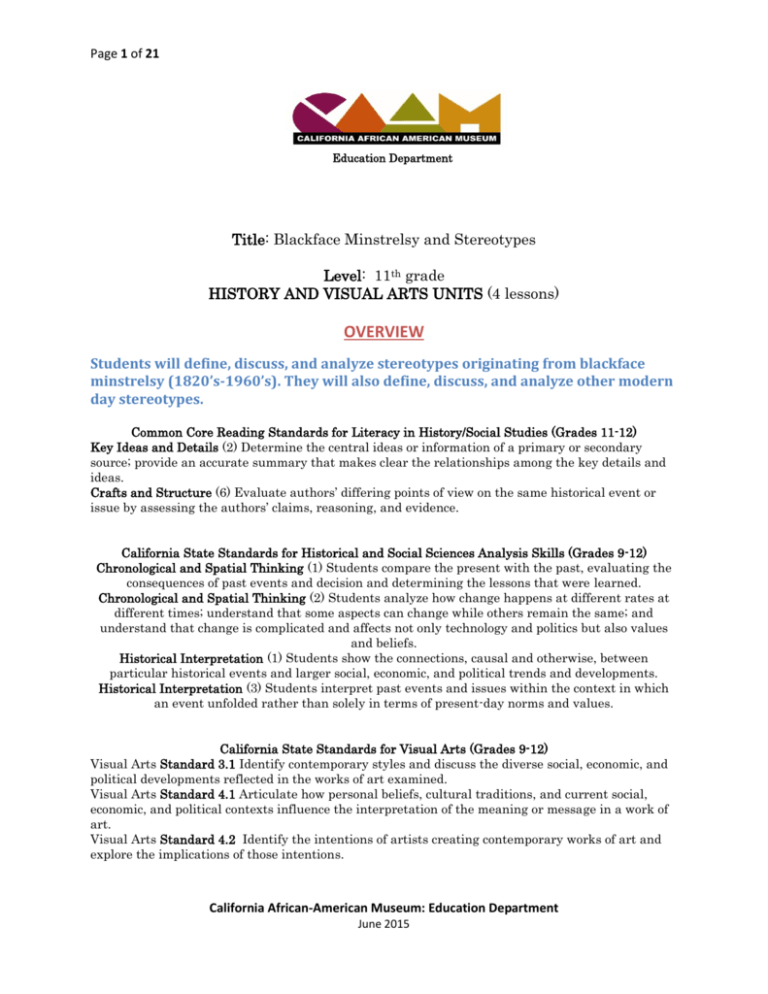
Page 1 of 21 Education Department Title: Blackface Minstrelsy and Stereotypes Level: 11th grade HISTORY AND VISUAL ARTS UNITS (4 lessons) OVERVIEW Students will define, discuss, and analyze stereotypes originating from blackface minstrelsy (1820’s-1960’s). They will also define, discuss, and analyze other modern day stereotypes. Common Core Reading Standards for Literacy in History/Social Studies (Grades 11-12) Key Ideas and Details (2) Determine the central ideas or information of a primary or secondary source; provide an accurate summary that makes clear the relationships among the key details and ideas. Crafts and Structure (6) Evaluate authors’ differing points of view on the same historical event or issue by assessing the authors’ claims, reasoning, and evidence. California State Standards for Historical and Social Sciences Analysis Skills (Grades 9-12) Chronological and Spatial Thinking (1) Students compare the present with the past, evaluating the consequences of past events and decision and determining the lessons that were learned. Chronological and Spatial Thinking (2) Students analyze how change happens at different rates at different times; understand that some aspects can change while others remain the same; and understand that change is complicated and affects not only technology and politics but also values and beliefs. Historical Interpretation (1) Students show the connections, causal and otherwise, between particular historical events and larger social, economic, and political trends and developments. Historical Interpretation (3) Students interpret past events and issues within the context in which an event unfolded rather than solely in terms of present-day norms and values. California State Standards for Visual Arts (Grades 9-12) Visual Arts Standard 3.1 Identify contemporary styles and discuss the diverse social, economic, and political developments reflected in the works of art examined. Visual Arts Standard 4.1 Articulate how personal beliefs, cultural traditions, and current social, economic, and political contexts influence the interpretation of the meaning or message in a work of art. Visual Arts Standard 4.2 Identify the intentions of artists creating contemporary works of art and explore the implications of those intentions. California African-American Museum: Education Department June 2015 Page 2 of 21 OBJECTIVES (SWBAT) 1. Construct and interpret personal identities and perceived stereotypes. 2. Engage in a discussion about stereotypes and formulate a definition of “stereotype” through collective class effort. 3. Chart and recognize different stereotypes that relate to race, religion, gender, etc. 4. Understand and asses the negative impact of stereotypes. 5. Understand and discuss the origins of blackface minstrelsy. 6. Name and describe minstrel archetypes and identify them in modern day media. 7. Analyze and reconstruct modern ads. MATERIALS: Lesson I: Hand Out A (p. 9) and Chart Paper Lesson II: Hand Out B (p. 10-14) and short clip from a blackface minstrel show (link on p. 10) Lesson III: Hand Out C (p. 15) and Ethnic Notions documentary (link on p. 3) Lesson IV: Hand Out D (p. 16-21) and Images of Ads (links on p. 3) Lesson V: (OPTIONAL LESSON) Colored Pencils, Markers, Crayons, etc. and Poster Paper PROCEDURE: LESSON I – Personal Identity and Stereotypes 1. Distribute Hand Out A (page 9). For this part of the activity, only use the inner circle and leave the outer ring blank. The students should create a pie chart that represents their identities. Examples are provided on pages 6-7. 2. When the students have finished, write the word stereotype on the board. Engage the class in a discussion about what a stereotype is and formulate a common definition. 3. Return to the identity pie chart. Ask students to describe stereotypes associated with the segments represented in the pie chart. They should write these in the outer ring. 4. Afterwards, bring out the chart paper. As a class, discuss the stereotypes in the students’ pie charts as well as other general stereotypes related to various races, religions, genders, etc. Catalogue these different stereotypes on the chart paper. An example is provided on page 8. Save this chart for Lesson V if needed. California African-American Museum: Education Department June 2015 Page 3 of 21 PROCEDURE : LESSON II – The Origins of Blackface Minstrelsy 1. Distribute Hand Out B (pages 10-14). 2. Read through Hand Out B as a class. Stop at all the discussion points. PROCEDURE: LESSON III – Minstrel Caricatures 1. Distribute Hand Out C (page 15). Read through the questions beforehand. 2. Watch Ethnic Notions, a documentary about minstrel characters in American popular media. Available on YouTube: https://www.youtube.com/watch?v=goJ77bYXnLA 3. Have the students fill out the worksheet after watching the documentary. PROCEDURE: LESSON IV – Stereotypes in Modern Media 1. Distribute Hand Out D (pages 16-21) 2. Pull up the following images: a. IMAGE 1—Ad for United Colors of Benetton, a clothing corporation: http://www.dlib.info/omeka/judith/archive/files/c8aa68c35aebed8d4f07953fad 5cb908.jpg b. IMAGE 2—Ad for the Drug and Alcohol Services for London to stop women from abusing alcohol: http://i.dailymail.co.uk/i/pix/2008/06/03/article-1023844-0177B50200000578717_468x577.jpg 3. Analyze the images by going over the questions in Hand Out D as a class. OPTIONAL ACTIVITY 4. Pull up images of these sports team mascots and go over the discussion questions on page 21: a. NFL Washington Red Skins b. MLB Cleveland Indians c. MLB Atlanta Braves California African-American Museum: Education Department June 2015 Page 4 of 21 OPTIONAL LESSON: Use as an Extended Lesson or assign as Homework PROCEDURE: LESSON V – Art Activity 1. Re-introduce the chart of various stereotypes created in Lesson I as a guide for the next activity. 2. Have the students find and bring advertisements that contain any stereotype(s). 3. The students should “scrub” their ads of perceived stereotypical images or messages. They should re-create their new ads on blank poster paper. The ads must maintain the promotion of the intended product or message. 4. Students should then present the new ads to the class. They should explain how they eliminated any stereotypes. Additional Resources to Supplement Lessons: 1. Social psychologist Claude M. Steele shares his illuminating research about stereotypes and social identity in his book: Whistling Vivaldi: How Stereotypes Affect Us and What We Can Do (Issues of Our Time) 2. Artist Mark Steven Greenfield’s series on blackface minstrelsy available online: http://www.markstevengreenfield.com/ 3. Interview with Greenfield about his minstrelsy series: http://www.latimes.com/entertainment/arts/miranda/la-et-cam-artist-mark-stevengreenfield-on-minstrelsy-and-american-culture-20141117-column.html#page=2 4. Twenty-minute PBS Documentary about blackface minstrelsy, its transition into vaudeville, and Black involvement in the entertainment industry during the time: https://www.youtube.com/watch?v=8kbnn3E7Gp8 5. Discussion with historians about the history and legacy of blackface minstrelsy: http://www.pbs.org/wgbh/amex/foster/sfeature/sf_minstrelsy.html 6. Links under “The Museum” and “Caricature” headings are particularly informative when learning about the origins of Jim Crow and blackface minstrelsy stereotypes and their legacies: http://www.ferris.edu/jimcrow/ 7. Nina Simone’s song “Four Women,” which touches on stereotypes about Black women: https://www.youtube.com/watch?v=WRmzQ39sXTQ California African-American Museum: Education Department June 2015 Page 5 of 21 Additional Resources for the Teacher: 1. Eric Lott’s Love & Theft: Blackface Minstrelsy and the American Working Class (Race and American Culture) 2. Robert Nowatzki’s Paddy Jumps Jim Crow: Irish-Americans and Blackface Minstrelsy 3. Series of essays edited by Stephen Johnson in Burnt Cork: Traditions and Legacies of Blackface Minstrelsy 4. Yuval Taylor and Jake Austen’s Darkest America: Black Minstrelsy from Slavery to Hip-Hop 5. Michael Pickering’s Blackface Minstrelsy in Britain 6. Ian Haney López’s Dog Whistle Politics ACTIVITIES AND HAND OUTS START ON PAGE 9 California African-American Museum: Education Department June 2015 Page 6 of 21 LESSON I: “Identity Pie Chart” Example California African-American Museum: Education Department June 2015 Page 7 of 21 LESSON I: “Identity Pie Chart” Example California African-American Museum: Education Department June 2015 Page 8 of 21 LESSON I: “Common Stereotypes Chart” Example Women African-American Woman Latina Women Asian Women Men African-American Men Latino Men Asian Men Jewish Muslim Christian Buddhist American Athlete Teenager Mother California African-American Museum: Education Department June 2015 HAND OUT A Page 9 of 21 LESSON I: Personal Identity and Stereotypes Use the inner circle to create a pie chart of your personal identity. The more important parts should take up a larger portion of the chart. Keep the outer ring clear for the second part of the activity. As you can see from your own identity pie chart, human beings are multi-faceted (having many aspects) and complex! California African-American Museum: Education Department June 2015 HAND OUT B Page 10 of 21 LESSON II: The Origins of Blackface Minstrelsy Blackface Minstrelsy: Emerging during the late 1820’s, this form of American entertainment usually involved white male performers parodying (ridiculing in an exaggerated manner) the songs, dances, and speech patterns of southern Blacks. The performers blackened their faces with burnt corks and exaggerated their lips. As one of the most popular forms of entertainment during the time, blackface minstrelsy commodified (to make into a commodity, usually for profit) racist stereotypes about African-Americans. Adapted from “Blackface Minstrelsy” entry from the 2nd edition of the St. James Encyclopedia of Popular Culture Photo of Charles Mack and George Moran as the "Two Black Crows.” The comedy team performed this act in vaudeville, on radio and records and in films. Image taken from http://commons.wikimedia.org. STOP and Watch: Short clip from a blackface minstrel show: https://www.youtube.com/watch?v=-_swtbIi2F0 HISTORICAL BACKGROUND Although accounts of blackface minstrel performances before the American Revolution exist, blackface minstrelsy developed in the late 1820’s and became popular during the 30’s and 40’s. Thomas Dartmouth Rice is frequently referred to as “the father of blackface minstrelsy.” Although the exact details vary, one account recalls Rice in 1828 watching a Black man in Louisville, Kentucky with a deformed right shoulder and arthritic left knee perform a song and dance called “Jump Jim Crow.” Rice mimicked the man’s disfigured form, foot-dragging dance steps, and manner of talking and dressing. In 1828 when Rice first performed “Jump Jim Crow” in blackface, the audience in Louisville roared with delight. White audience members allegedly stopped the performance and demanded twenty more encores. His show became a sensation throughout the 1830s and 1840s, and thus, Rice has been described as America’s first entertainment superstar. In 1836, he took his act to England, where it also became popular. During the 1840’s, blackface minstrelsy became the most common form of entertainment in the United States. Americans saw it on the stages of theaters and circuses, read about it in the popular novels of the nineteenth century, heard it over the radio, and viewed it on film and television. Adapted from “Blackface Minstrelsy” entry from the 2nd edition of the St. James Encyclopedia of Popular Culture STOP and California Discuss: African-American What is the Museum: purpose and Education intent ofDepartment blackface minstrelsy? June 2015 HAND OUT B Page 11 of 21 Scholars have proposed various theories as to why blackface minstrelsy became so popular. Despite the diversity in the field, all of the scholars connect their concepts to the economic, social, political, and cultural issues of the time. Robert Toll for example proposes that after the War of 1812, Americans desired a native cultural form separate from the British as a way to affirm political independence. Though white elites looked towards American artists to elevate European forms and concepts to a new level, the rest of America wanted a more egalitarian (aiming for equal wealth, status, etc. for all people), anti-aristocratic, and anti-European approach like blackface minstrelsy. Another scholar Thandeka argues that white Americans desired what the “black image” on the minstrelsy stage represented: the sensuality and freeplay of pre-modern times. Although the white workers yearned for these qualities, these traits were incompatible with the “good work” ethic required for a capitalist and industrial workplace. Lastly, Eric Lott argues that blackface minstrelsy arose because white Americans simultaneously feared, desired, and were fascinated by Black culture. Blackface minstrelsy allowed white Americans to “try on” Blackness. He also mentions that many participants of minstrel shows were often part of the northern white working class (vs. elite upper class), as these shows eased anxieties of class differences by catering to the working class’s sense of white superiority. Adapted from “What Teacher Education Can Learn from Blackface Minstrelsy” by Timothy J. Lensmire and Nathan Snaza. STOP and Discuss: Do you agree or disagree with the arguments made by Robert Toll, Thandeka, and Eric Lott? Why or why not? During the 1850s, the well-known stereotypes of African Americans were cultivated and refined (see “Common Archetypes” on pages 13-14). In the years after the Civil War (1861-1865), Black performers flooded the minstrel stage, but they were required to put on blackface makeup regardless of their skin tones. Blackface minstrelsy was more profitable and practical than other laborious jobs and allowed African-American musicians, actors, and dancers an opportunity to practice their crafts. Some minstrel shows, especially those in the South, also managed to subtly poke fun at racist attitudes and double standards. STOP and Discuss: Why do you think Black performers were required to wear blackface makeup? If you were a Black performer during this period, would you have participated in blackface minstrel shows? In the 1890s-1920s, blackface minstrelsy began to dwindle in professional theaters. However, traces of minstrelsy can be easily identified in vaudeville (a genre in theater), musical revues, American musical theater, and films. Even today, we see California African-American Museum: Education Department June 2015 HAND OUT B Page 12 of 21 forms of blackface and/or modern minstrelsy in advertisements, films, news media, college parties, and much more. Adapted from “Blackface Minstrelsy” entry from the 2nd edition of the St. James Encyclopedia of Popular Culture, “Minstrelsy” entry from the 2nd edition of the International Encyclopedia of the Social Sciences, and http://www.blackhistory.com CHARACTERISTICS OF BLACKFACE MINSTREL SHOWS Although the form and content of blackface minstrelsy performance underwent changes over time, the performance generally included five white men with exaggerated lips and faces blackened with burnt cork or grease paint. The performers usually arranged themselves in a semi-circle, and in the middle stood Mr. Interlocutor—a sort of master of ceremonies—who dressed more formally than the other performers. On either side of Mr. Interlocutor were Mr. Tambo, who played the tambourine, and Mr. Bones, who played the bone castanets (a type of percussion instrument). The show consisted of three parts. The first part included a random selection of songs and jokes. The second part called “olio” featured novelty performances such as comic dialogues, cross-dressing “wench” performances, and political “stump speeches” with malapropisms (wrongly using a word that sounds like another word, e.g. “dancing the flamingo” instead of “dancing the flamenco”). The third part incorporated a narrative skit—usually set in the South—filled with dancing, music, and burlesque. Adapted from “Blackface Minstrelsy” entry from the 2nd edition of the St. James Encyclopedia of Popular Culture and “What Teacher Education Can Learn from Blackface Minstrelsy” by Timothy J. Lensmire and Nathan Snaza. STOP and Discuss: Give another example of a malapropism. California African-American Museum: Education Department June 2015 HAND OUT B Page 13 of 21 COMMON ARCHTEYPES Minstrel characters’ traits often overlapped with each other, and many performances can be seen as a combination of the different stereotypes. Thus in some performances, it is difficult to unequivocally distinguish some characters from others. Despite this difficulty, however, it is important to recognize these characters to understand how these stereotypes shaped history and how they impact the present day. Images of Jim Crow, Zip Coon, and Mammy respectively. Taken from http://commons.wikimedia.org. Jim Crow: Thomas D. Rice, the “father of blackface minstrelsy,” appeared on stage in 1828 as “Jim Crow.” Jim Crow became a reoccurring character in Rice’s performances. Although originally a fictional stage character, Jim Crow later became the name for segregation laws in the post-Reconstruction period and twentieth century. Sambo: Evolved from Jim Crow. A simple, docile, subservient, and carefree Black man. Sambo was often irresponsible and quick to avoid work, though he enjoyed the easy pleasures of food, dance, and song. Zip Coon: A northern, urban freedman, who often appeared to be pretentious (making oneself appear greater than one actually is). He dressed in high style and attempted to speak intelligently, though he often spoke in malapropisms, which undermined his efforts to appear dignified. This type of character mocked freed Black Americans. Coon: A combination of the Jim Crow and Zip Coon characters. The Coon character was a dumb and lazy man, who always tried to get out of work. He often talked with a slow drawl and had wide eyes. California African-American Museum: Education Department June 2015 HAND OUT B Page 14 of 21 Mammy: A cook, maid, and/or plump caregiver. She was an obedient child-like woman, who was loyal to her white family. The mammy image was used to defend slavery, as she was portrayed as content—and even happy—as a slave. Today, we still see mammy images used in advertising products such as Aunt Jemima Pancake mixes, although she has since been recreated as a lighter-skinned maid without the handkerchief around her head. The Aunt Jemima name was borrowed from a popular vaudeville song. (Uncle) Tom: A happy, loyal, and submissive butler, doorman, waiter, cook, and/or servant. He was sometimes self-deprecating (belittling oneself). Could be seen as the male counterpart to mammy, as the Tom caricature also served as a justification for slavery. In contrast to the Coon, the Tom is a dependable worker and eager to serve. He is often portrayed as being psychologically dependent on whites for approval. Harriet Beecher Stowe’s novel Uncle Tom’s Cabin contains a character named Uncle Tom, but the character on stage lacked many of the positive qualities present in the character in the novel. Pickaninny: A small Black child with animal-like qualities: unkempt hair, bulging eyes, red lips, tattered clothes. “Child coons” who were sometimes portrayed eating watermelon. Often shown on postcards and posters being chased or eaten by alligators. The term pickaninny or picaninny was used to refer to black children in America and England and shortened to “pickney” in places like Jamaica. Brute: A universal description of a savage, criminal, predatory, animalistic man, this archetype portrayed the Black man as the sole representative of these traits. The Black brute was often seen as a threat to white society, specifically as a potential rapist of white women. The perpetuation of this stereotype provided the excuse for lynching by mob justice of many innocent Black men. The Black man as brute is the opposite of the Tom caricature. Wench/Jezebel: While the archetype of the Wench/Jezebel is universal, in Blackface Minstrelry this imagery of Black women contrasted with portrayals of white women as pure, modest, self-respecting, and self-controlled. This stereotype of Black women as promiscuous, lewd, and seductive often justified the sexual abuse of Black women and girls, especially during slavery. Definitions adapted from: http://www.ferris.edu/ under “Caricature” links. STOP and Discuss: Do you see any connections between the blackface minstrel show characters and the portrayals of Black Americans in the media today? If so, give examples. What role do you think entertainment and the media play in creating or continuing stereotypes about groups of people? California African-American Museum: Education Department June 2015 Page 15 of 21 HAND OUT C LESSON III: Minstrel Caricatures Watch the documentary Ethnic Notions and answer the following questions. 1) What is blackface minstrelsy’s relationship to the Abolitionist Movement? 2) Why did the Zipcoon character develop? 3) Who was Bert Williams? 4) What do you think is the legacy of blackface minstrelsy and the characters? California African-American Museum: Education Department June 2015 Page 16 of 21 HAND OUT D LESSON IV: Stereotypes in Modern Media IMAGE 1 This image is an advertisement for a clothing corporation called United Colors of Benetton. 1) What do you see? 2) Fill out the chart to help you analyze the advertisement. Child on the Left Child on the Right Describe the facial expression for each child. How do these qualities make you feel about this child? How do these qualities make you feel about this child? California African-American Museum: Education Department June 2015 Page 17 of 21 HAND OUT D Describe the hairstyle for each child. How do these qualities make you feel about this child? How do these qualities make you feel about this child? 3) Why do you think the children juxtaposed (to place side by side, especially for comparison) the way they are? 4) Can you see any historical connections in the imagery of this advertisement? If so, explain. California African-American Museum: Education Department June 2015 Page 18 of 21 HAND OUT D 5) What message does this advertisement send? To whom is it a service or disservice? 6) What is your reaction to this ad? California African-American Museum: Education Department June 2015 Page 19 of 21 HAND OUT D IMAGE 2: This image is a campaign created by the Drug and Alcohol Services for London. 1) What do you see? Describe in detail. 2) Now, read the text in the ad and paraphrase what you read. 3) Who created the ad and what for? 4) How is this ad specifically directed towards women? California African-American Museum: Education Department June 2015 Page 20 of 21 HAND OUT D 5) What do you think this ad implies about men? What gender stereotypes are presented in this ad? 6) How do you feel about the tactics used in the ad? Explain. California African-American Museum: Education Department June 2015 Page 21 of 21 HAND OUT D IMAGES OF SPORTS MASCOTS 1) Who or what are usually sports team mascots? 2) Why are Native Americans as a group singled out as sports mascots? Do you see any connection to how Native Americans have been historically viewed or portrayed? 3) Do you think these sports teams should change their mascots? Why or why not? California African-American Museum: Education Department June 2015
